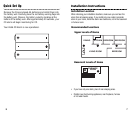
What To Do If The Alarm Sounds (cont.)
Symptoms of CO Poisoning
The following common symptoms are related to carbon monoxide
poisoning and should be discussed with ALL members of the
household. Learn the difference between mild, medium and
extreme levels.
Caution: This CO alarm will only indicate the presence of CO at
the sensor. CO may be present in other areas.
Mild Exposure: Slight headache, nausea, vomiting, fatigue (often
described as “Flu-like” symptoms).
Medium Exposure: Severe throbbing headache, drowsiness,
confusion, fast heart rate.
Extreme Exposure:
Unconsciousness, convulsions, cardiorespiratory failure, death.
Many cases of reported CARBON MONOXIDE POISONING
indicate that while victims are aware they are not well, they
become so disoriented they are unable to save themselves by
either exiting the building or calling for assistance. Young
children and household pets are typically the first affected.
If you experience even mild symptoms of CO poisoning, consult
your doctor immediately!
Part Four – What to do When the
Alarm Sounds
▲
!
WARNING: Actuation of your CO
Alarm indicates the presence of Carbon
Monoxide (CO) which can KILL YOU.
1) Operate test/reset button;
2) Call your emergency services
(fire dept. or 911);
3) Immediately move to fresh air - outdoors or by an open door/win-
dow. Do a head count to check that all persons are accounted for. Do
not re-enter the premises nor move away from the open door/win-
dow until the emergency services responders have arrived, the
premises have been aired out, and your alarm remains in its normal
condition.
4) After following steps 1-3, if your alarm reactivates within a 24 hour
period, repeat steps 1-3 and call a qualified appliance technician to
investigate for sources of CO from fuel burning equipment and
appliances, and inspect for proper operation of this equipment.
If problems are identified during this inspection have the equipment
serviced immediately. Note any combustion equipment not inspected
by the technician and consult the manufacturer’s instructions, or con-
tact the manufacturer’s directly, for more information about CO safety
and this equipment. Make sure that motor vehicles are not, and have
not been, operating in an attached garage or adjacent to the resi-
dence.
Never restart the source of a CO problem until it has been corrected.
Never ignore the sound of the alarm!
PHONE NUMBER
PHONE NUMBER
18
19

















